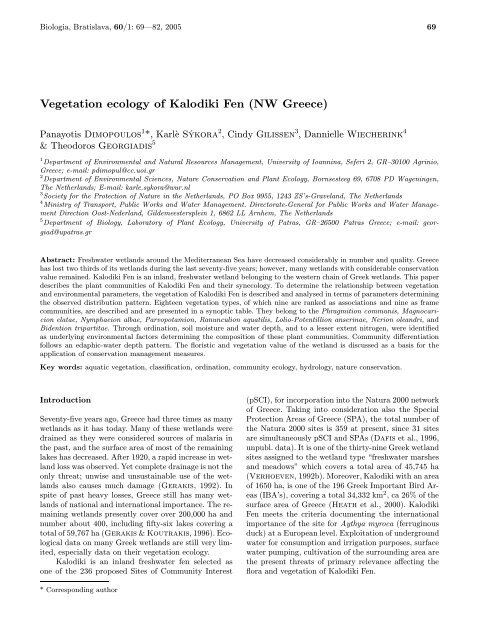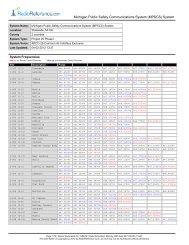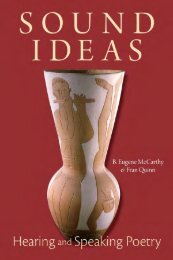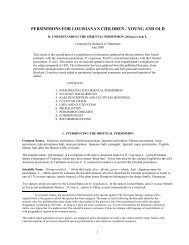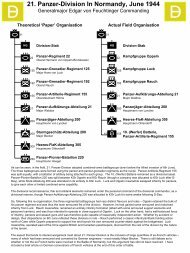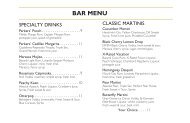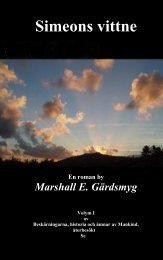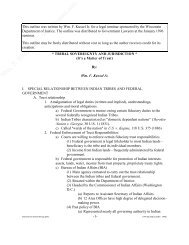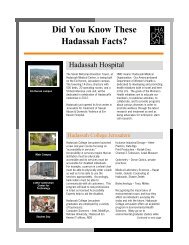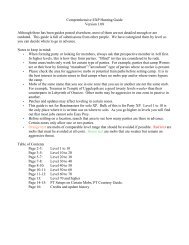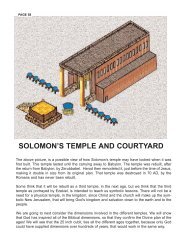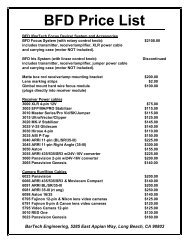Vegetation ecology of Kalodiki Fen (NW Greece)
Vegetation ecology of Kalodiki Fen (NW Greece)
Vegetation ecology of Kalodiki Fen (NW Greece)
You also want an ePaper? Increase the reach of your titles
YUMPU automatically turns print PDFs into web optimized ePapers that Google loves.
Biologia, Bratislava, 60/1: 69—82, 2005 69<br />
<strong>Vegetation</strong> <strong>ecology</strong> <strong>of</strong> <strong>Kalodiki</strong> <strong>Fen</strong> (<strong>NW</strong> <strong>Greece</strong>)<br />
Panayotis Dimopoulos 1 *,Karlè Sýkora 2 , Cindy Gilissen 3 , Dannielle Wiecherink 4<br />
& Theodoros Georgiadis 5<br />
1<br />
Department <strong>of</strong> Environmental and Natural Resources Management, University <strong>of</strong> Ioannina, Seferi 2, GR–30100 Agrinio,<br />
<strong>Greece</strong>; e-mail: pdimopul@cc.uoi.gr<br />
2<br />
Department <strong>of</strong> Environmental Sciences, Nature Conservation and Plant Ecology, Bornsesteeg 69, 6708 PD Wageningen,<br />
The Netherlands; E-mail: karle.sykora@wur.nl<br />
3<br />
Society for the Protection <strong>of</strong> Nature in the Netherlands, PO Box 9955, 1243 ZS’s-Graveland, The Netherlands<br />
4<br />
Ministry <strong>of</strong> Transport, Public Works and Water Management. Directorate-General for Public Works and Water Management<br />
Direction Oost-Nederland, Gildemeestersplein 1, 6862 LL Arnhem, The Netherlands<br />
5<br />
Department <strong>of</strong> Biology, Laboratory <strong>of</strong> Plant Ecology, University <strong>of</strong> Patras, GR–26500 Patras <strong>Greece</strong>; e-mail: georgiad@upatras.gr<br />
Abstract: Freshwater wetlands around the Mediterranean Sea have decreased considerably in number and quality. <strong>Greece</strong><br />
has lost two thirds <strong>of</strong> its wetlands during the last seventy-five years; however, many wetlands with considerable conservation<br />
value remained. <strong>Kalodiki</strong> <strong>Fen</strong> is an inland, freshwater wetland belonging to the western chain <strong>of</strong> Greek wetlands. This paper<br />
describes the plant communities <strong>of</strong> <strong>Kalodiki</strong> <strong>Fen</strong> and their syn<strong>ecology</strong>. To determine the relationship between vegetation<br />
and environmental parameters, the vegetation <strong>of</strong> <strong>Kalodiki</strong> <strong>Fen</strong> is described and analysed in terms <strong>of</strong> parameters determining<br />
the observed distribution pattern. Eighteen vegetation types, <strong>of</strong> which nine are ranked as associations and nine as frame<br />
communities, are described and are presented in a synoptic table. They belong to the Phragmition communis, Magnocaricion<br />
elatae, Nymphaeion albae, Parvopotamion, Ranunculion aquatilis, Lolio-Potentillion anserinae, Nerion oleandri, and<br />
Bidention tripartitae. Through ordination, soil moisture and water depth, and to a lesser extent nitrogen, were identified<br />
as underlying environmental factors determining the composition <strong>of</strong> these plant communities. Community differentiation<br />
follows an edaphic-water depth pattern. The floristic and vegetation value <strong>of</strong> the wetland is discussed as a basis for the<br />
application <strong>of</strong> conservation management measures.<br />
Key words: aquatic vegetation, classification, ordination, community <strong>ecology</strong>, hydrology, nature conservation.<br />
Introduction<br />
Seventy-five years ago, <strong>Greece</strong> had three times as many<br />
wetlands as it has today. Many <strong>of</strong> these wetlands were<br />
drained as they were considered sources <strong>of</strong> malaria in<br />
the past, and the surface area <strong>of</strong> most <strong>of</strong> the remaining<br />
lakes has decreased. After 1920, a rapid increase in wetland<br />
loss was observed. Yet complete drainage is not the<br />
only threat; unwise and unsustainable use <strong>of</strong> the wetlands<br />
also causes much damage (Gerakis, 1992). In<br />
spite <strong>of</strong> past heavy losses, <strong>Greece</strong> still has many wetlands<br />
<strong>of</strong> national and international importance. The remaining<br />
wetlands presently cover over 200,000 ha and<br />
number about 400, including fifty-six lakes covering a<br />
total <strong>of</strong> 59,767 ha (Gerakis & Koutrakis, 1996). Ecological<br />
data on many Greek wetlands are still very limited,<br />
especially data on their vegetation <strong>ecology</strong>.<br />
<strong>Kalodiki</strong> is an inland freshwater fen selected as<br />
one <strong>of</strong> the 236 proposed Sites <strong>of</strong> Community Interest<br />
* Corresponding author<br />
(pSCI), for incorporation into the Natura 2000 network<br />
<strong>of</strong> <strong>Greece</strong>. Taking into consideration also the Special<br />
Protection Areas <strong>of</strong> <strong>Greece</strong> (SPA), the total number <strong>of</strong><br />
the Natura 2000 sites is 359 at present, since 31 sites<br />
are simultaneously pSCI and SPAs (Dafis et al., 1996,<br />
unpubl. data). It is one <strong>of</strong> the thirty-nine Greek wetland<br />
sites assigned to the wetland type “freshwater marshes<br />
and meadows” which covers a total area <strong>of</strong> 45,745 ha<br />
(Verhoeven, 1992b). Moreover, <strong>Kalodiki</strong> with an area<br />
<strong>of</strong> 1650 ha, is one <strong>of</strong> the 196 Greek Important Bird Areas<br />
(IBA’s), covering a total 34,332 km 2 , ca 26% <strong>of</strong> the<br />
surface area <strong>of</strong> <strong>Greece</strong> (Heath et al., 2000). <strong>Kalodiki</strong><br />
<strong>Fen</strong> meets the criteria documenting the international<br />
importance <strong>of</strong> the site for Aythya myroca (ferruginous<br />
duck) at a European level. Exploitation <strong>of</strong> underground<br />
water for consumption and irrigation purposes, surface<br />
water pumping, cultivation <strong>of</strong> the surrounding area are<br />
the present threats <strong>of</strong> primary relevance affecting the<br />
flora and vegetation <strong>of</strong> <strong>Kalodiki</strong> <strong>Fen</strong>.
70 P. Dimopoulos et al.<br />
<strong>Kalodiki</strong> <strong>Fen</strong> belongs to the western chain <strong>of</strong> Greek<br />
wetlands situated along the coast <strong>of</strong> the Ionian Sea.<br />
This chain includes extensive deltas and lagoons in<br />
Kyparissiakos, Patraikos and Amvrakikos Gulfs, the<br />
Akarnanian lakes and marshes, and the lakes <strong>of</strong> Epiros<br />
(Fig. 1). <strong>Kalodiki</strong> <strong>Fen</strong> is <strong>of</strong> ecological interest because<br />
<strong>of</strong> its wildlife, especially the bird fauna, water<br />
quality (Kourteli & Economou, 1992), interesting<br />
flora, well-developed aquatic vegetation (Sarika-<br />
Hatzinikolaou, 1999; Sarika-Hatzinikolaou et al.,<br />
1993a,b, 1996, 2003) and landscape value.<br />
This paper aims at: a) performing a detailed vegetation<br />
survey by means <strong>of</strong> phytosociological and gradient<br />
analytical methods, b) relating and the results<br />
with the hydrology <strong>of</strong> <strong>Kalodiki</strong> wetland, c) providing a<br />
plant-ecological interpretation <strong>of</strong> the established communities,<br />
and d) providing the necessary ecological basis<br />
for the conservation management <strong>of</strong> <strong>Kalodiki</strong> <strong>Fen</strong>.<br />
Study area<br />
<strong>Kalodiki</strong> <strong>Fen</strong> is located in W Epiros, <strong>NW</strong> <strong>Greece</strong> (Fig. 1)<br />
and it extends between 20 ◦ 26 ′ 46 ′′ E and 20 ◦ 28 ′ 14 ′′ E and<br />
39 ◦ 19 ′ 20 ′′ Nand39 ◦ 17 ′ 53 ′′ N. <strong>Kalodiki</strong> wetland consists <strong>of</strong><br />
one large and one small lake embedded in a topogenous<br />
mire or fen, located in a small basin representing a tectonic<br />
depression. The fen consists <strong>of</strong> two peat lands very close to<br />
each other occupying together an area <strong>of</strong> 195 ha surrounded<br />
by hills <strong>of</strong> 550 m altitude.<br />
During the Late Glacial period, a freshwater lake supplied<br />
mainly by karstic water occupied the greatest part<br />
<strong>of</strong> the basin. Since the beginning <strong>of</strong> the Holocene epoch,<br />
Fig. 1. Map <strong>of</strong> <strong>Greece</strong>. The position <strong>of</strong> <strong>Kalodiki</strong><br />
and the most important wetlands <strong>of</strong> Western <strong>Greece</strong><br />
are indicated. 1: Kalamas Delta; 2: <strong>Kalodiki</strong> <strong>Fen</strong>;<br />
3: Acheron Delta; 4: Louros-Arachtos Delta and<br />
Amvrakikos Gulf; 5: Lakes Vulkaria and Saltini; 6:<br />
Acheloos Delta, Lagoon Messolongi-Aitolikon and estuaries<br />
<strong>of</strong> River Evros; 7: Str<strong>of</strong>ilia coastal area; 8:<br />
Pineios Delta; 9: Alfeios Delta.<br />
peat accumulated gradually, and consequently the SSE <strong>of</strong><br />
the basin converted into a fen. In 1992, the average peat<br />
formation was 3.5m and 0.5m thick in the largest and smallest<br />
fen, respectively. Since the Late Pleistocene, the sea<br />
has not influenced <strong>Kalodiki</strong> <strong>Fen</strong> and since 11,000 B.C. it<br />
has <strong>of</strong>ten been flooded by surface freshwaters. Today, inorganic<br />
material carried by brooks and rivulets also flows into<br />
the basin forming alluvial fans. The water level <strong>of</strong> <strong>Kalodiki</strong><br />
wetland fluctuates seasonally and is highest during winter.<br />
More specifically, SARIKA-HATZINIKOLAOU et al. (1993a)<br />
recorded a water level fluctuation <strong>of</strong> 0–5 m. In <strong>Greece</strong>, 1987–<br />
1994 were very dry years resulting in a low water level and,<br />
according to BOTIS et al. (1993), in the autumn <strong>of</strong> 1992<br />
<strong>Kalodiki</strong> <strong>Fen</strong> dried out completely; surface water was absent<br />
and the groundwater table dropped to 1.5–2.5 m below the<br />
soil surface. After reflooding, the freshwater, aquatic plant<br />
communities proved to be very resilient. The fresh alkaline<br />
water is very clear, has a low hardness value (144–205 mg/L<br />
CaCO3) and is rich in phosphorus, nitrogen and iron. Based<br />
on these data, GEORGIADIS (1994) concluded that the fen<br />
is not influenced by pollution.<br />
Material and methods<br />
Recording relevés and species identification<br />
During May and June 1996, 299 relevés were made according<br />
to the Braun-Blanquet method (KENT &COKER,<br />
1992; WESTHOFF & VAN DER MAAREL, 1973). In plots <strong>of</strong> 6<br />
m 2 cover-abundance was estimated using the extended (9point)<br />
Braun-Blanquet scale (BARKMAN et al., 1964). Plant<br />
species were sampled using a rake in order to explore the<br />
whole volume <strong>of</strong> each relevé. Taxa nomenclature in this paper<br />
follows STRID &TAN (1997, 2002) and TUTIN et al.<br />
(1968–1993).
<strong>Vegetation</strong> <strong>ecology</strong> <strong>of</strong> <strong>Kalodiki</strong> <strong>Fen</strong>... 71<br />
For phytosociological identification and syntaxonomic<br />
assignment <strong>of</strong> the plant communities we used HORVAT et al.<br />
(1974), OBERDORFER (1990), POTT (1992), SCHAMINÉE et<br />
al. (1995), SCHUBERT et al. (1995), RODWELL et al. (1995)<br />
and RODWELL et al. (2002). Apart from saturated communities<br />
(associations), unsaturated, so-called frame communities,<br />
were distinguished using the deductive method<br />
(KOPECKÝ, 1978; KOPECKÝ &HEJNÝ, 1978). A plant community<br />
is considered phytosociologically saturated if it can<br />
be assigned to the association level, because sufficient numbers<br />
<strong>of</strong> characteristic species <strong>of</strong> that level are present. With<br />
increasing disturbance, and occasionally natural dynamics,<br />
character species <strong>of</strong> lower classification levels disappear and<br />
plant communities can only be assigned at the level <strong>of</strong> alliance,<br />
order or class. The differential species mentioned in<br />
this overview <strong>of</strong> plant communities are not differential in a<br />
syntaxonomic sense; they differentiate the communities as<br />
found in the <strong>Kalodiki</strong> wetland.<br />
The vegetation map (Fig. 2) was drawn by estimating<br />
the distances between borders while rowing through the<br />
wetland and by using the GPS coordinates <strong>of</strong> the relevés.<br />
The distances between the borders <strong>of</strong> the inaccessible plant<br />
communities in the centre <strong>of</strong> the fen were estimated.<br />
Environmental factors<br />
Water depth was measured in each relevé. As the water level<br />
dropped gradually, later measurements had to be adjusted<br />
to one date, i.e. the beginning <strong>of</strong> May. For this reason, the<br />
lowering <strong>of</strong> the water level was measured regularly during<br />
the research period (Fig. 3).<br />
In June 1996, water samples were taken and tested for<br />
electric conductivity and pH. For this sampling, five relevés<br />
were selected per plant community by means <strong>of</strong> a DCA ordination<br />
plot (HILL, 1979b). The even distribution <strong>of</strong> the selected<br />
relevés, from one cluster, over the ordination diagram<br />
was used as a criterion for the selection <strong>of</strong> these relevés.<br />
For each relevé, weighted mean Ellenberg indicator values<br />
(ELLENBERG et al., 1992) were calculated for moisture<br />
0<br />
Dam:<br />
cm below the top <strong>of</strong> the dam<br />
-10<br />
-20<br />
-30<br />
-40<br />
-50<br />
-60<br />
-70<br />
30/05/96<br />
04/06/96<br />
09/06/96<br />
14/06/96<br />
y = -1,0529x + 37056<br />
R 2 = 0,9979<br />
Fig. 2. <strong>Vegetation</strong> map <strong>of</strong> <strong>Kalodiki</strong><br />
<strong>Fen</strong>. The codes for the<br />
vegetation mapping units (1–<br />
20) included in the legend are<br />
in correspondence with the described<br />
plant communities, except<br />
for 1: non-cultivated land<br />
and abandoned fields, and 5:<br />
water.<br />
Fig. 3. Change in the water level <strong>of</strong> <strong>Kalodiki</strong> <strong>Fen</strong> during the<br />
summer season <strong>of</strong> 1996.<br />
and nitrogen. The average values were weighed by the ordinal<br />
cover-abundance values (VAN DER MAAREL, 1979).<br />
Data analysis<br />
The relevés were classified by means <strong>of</strong> TWINSPAN (HILL,<br />
1979a). A few relevés were reshuffled by hand in order to obtain<br />
more homogenous clusters. The final full table has been<br />
summarized into a synoptic table, indicating constancy class<br />
and characteristic cover. Characteristic cover means the average<br />
<strong>of</strong> the cover values <strong>of</strong> a species within a cluster excluding<br />
zero presence. Species with comparable syntaxonomic<br />
status were grouped into syntaxonomic species groups. The<br />
same species present in differential, as well as in constant<br />
species groups are marked by an asterisk (*) and given once.<br />
Ordination analyses were carried out using the CANO-<br />
CO package (TER BRAAK & ŠMILAUER, 1998). Waterdepth,<br />
pH, and Ellenberg figures were related to the first<br />
two axes <strong>of</strong> an indirect (DCA) ordination on separate relevés<br />
and on cluster centroids. A direct (CCA) ordination was also<br />
performed on the cluster centroids (Fig. 6). The coefficients<br />
19/06/96<br />
24/06/96<br />
29/06/96<br />
04/07/96<br />
09/07/96
72 P. Dimopoulos et al.<br />
0<br />
50<br />
100<br />
150<br />
200<br />
250<br />
300<br />
350<br />
400<br />
450<br />
6V<br />
3SM<br />
5A<br />
4E<br />
2R<br />
16M<br />
7L<br />
Fig. 5. Relation between the order <strong>of</strong> plant communities along<br />
the first axis <strong>of</strong> a CCA analysis with water depth. The plant<br />
community codes are given in Table 1.<br />
<strong>of</strong> determination (r 2 ) were calculated and are presented in<br />
the results. A Monte Carlo permutation test was performed<br />
to investigate the statistical significance <strong>of</strong> the effects <strong>of</strong> the<br />
impact variable.<br />
Results and discussion<br />
<strong>Vegetation</strong> types<br />
Eighteen plant communities within the fourth level<br />
<strong>of</strong> division were selected for interpretation in the<br />
TWINSPAN classification <strong>of</strong> the <strong>Kalodiki</strong> vegetation<br />
data. The syntaxonomic assignment <strong>of</strong> these plant communities<br />
is given in Table 1. In the synoptic table<br />
(Tab. 2), the species composition <strong>of</strong> each plant community<br />
is summarized. In each column, representing<br />
one plant community, the frequency and mean ordinal<br />
cover-abundance value are given. A description <strong>of</strong><br />
the floristic structure, <strong>ecology</strong> and syntaxonomy <strong>of</strong> the<br />
plant communities is given below. The vegetation map<br />
17PT<br />
8SL<br />
12T<br />
1C<br />
11PL<br />
14P2<br />
15N<br />
18CD<br />
15N<br />
14P2<br />
11PL<br />
12T<br />
8SL<br />
10PA<br />
13P1<br />
9G<br />
Fig. 4. Mean water depth<br />
(cm) in the different plant<br />
communities during May, as<br />
extrapolated using Figure 3.<br />
The standard deviation is<br />
indicated. For an explanation<br />
<strong>of</strong> the plant community<br />
codes see Table 1. The plant<br />
communities are sorted by<br />
their presence in <strong>Kalodiki</strong><br />
fen, from the west side to the<br />
east side.<br />
Fig. 6. CCA ordination diagram <strong>of</strong> the cluster centroids <strong>of</strong> the<br />
plant communities distinguished in <strong>Kalodiki</strong> <strong>Fen</strong> and environmental<br />
variables. Arrows indicate the relation between water<br />
depth, nitrogen, moisture, pH and the ordination axes. The plant<br />
community codes are given in Table 1.<br />
(Fig. 2) shows the distribution pattern <strong>of</strong> the described<br />
plant communities. The description <strong>of</strong> the distinguished<br />
vegetation types follows their assignment into high-rank<br />
syntaxa.<br />
I) Phragmito-Magnocaricetea<br />
In <strong>Kalodiki</strong> <strong>Fen</strong> five associations and one fragmentary<br />
or coenologically unsaturated, so-called “frame community”,<br />
represent the Phragmito-Magnocaricetea.<br />
Frame community <strong>of</strong> Phalaris arundinacea<br />
– [Phragmito-Magnocaricetea] (Cluster 10PA,<br />
Tab. 2, <strong>Vegetation</strong> mapping unit: 20)<br />
Syntaxonomy: This cluster <strong>of</strong> relevés has been assigned<br />
to the frame community due to the dominance
<strong>Vegetation</strong> <strong>ecology</strong> <strong>of</strong> <strong>Kalodiki</strong> <strong>Fen</strong>... 73<br />
Table 1. Syntaxonomic overview <strong>of</strong> the plant communities in <strong>Kalodiki</strong> wetland and their nutrient availability.<br />
ÈÖÑØÓ ÅÒÓ Ö Ø KLIKA in KLIKA et NOVÁK 1941<br />
ÈÖÑØØÐ KOCH 1926<br />
**Frame community <strong>of</strong> Phalaris arundinacea –[Phragmitetalia]<br />
ÈÖÑØÓÒ ÓÑÑÙÒ× KOCH 1926<br />
**Scirpetum lacustris CHOUARD 1924<br />
*Alismo-Scirpetum maritimi (TX. 1937) SCHAMINÉE, VAN ’T VEER et WEEDA 1995<br />
*subass. inops SCHAMINÉE, VAN ’T VEER et WEEDA 1995<br />
**Typho-Phragmitetum (KOCH 1926) SCHAMINÉE, VAN ’T VEER et WEEDA 1995<br />
**typhetosum angustifoliae SCHAMINÉE, VAN ’T VEER et WEEDA 1995<br />
**subass. typicum SCHAMINÉE, VAN ’T VEER et WEEDA 1995<br />
*Eleocharitetum palustris SCHENNIKOW 1919<br />
ÅÒÓ Ö ÓÒ ÐØ KOCH 1926<br />
*Caricetum gracilis ALMQUIST 1929<br />
ÈÓØÑØ KLIKA in KLIKA et NOVAK 1941<br />
**Frame community <strong>of</strong> Myriophyllum spicatum –[Potametea]<br />
ÈÓØÑØÐ KOCH 1926 em. SCHAMINÉE et al. 1990<br />
***Frame community <strong>of</strong> Ceratophyllum demersum –[Nupharo-Potametalia]<br />
ÆÝÑÔÓÒ Ð OBERD. 1957<br />
**Potametum lucentis HUECK 1931<br />
**Myriophyllo-Nupharetum KOCH ex HUECK 1931<br />
ÈÖÚÓÔÓØÑÓÒ (VOLLMAR 1947) DEN HARTOG et SEGAL 1964<br />
*Frame community <strong>of</strong> Potamogeton trichoides [Parvopotamion]<br />
ÊÒÙÒ ÙÐÓÒ ÕÙØÐ× PASSARGE 1964<br />
*Ranunculetum aquatilis SAUER 1947<br />
**Transitional unit between Typho-Phragmitetum, Potametum lucentis and Myriophyllo-Nupharetum<br />
ÅÓÐÒÓ ÖÖÒØÖØ Tx. 1937<br />
ÈÓØÒØÐÐÓ ÈÓÐÝÓÒØÐ Tx. 1947<br />
ÄÓÐÓ – ÈÓØÒØÐÐÓÒ Ò×ÖÒ TX. 1947<br />
*Frame community <strong>of</strong> Agrostis stolonifera [Lolio-Potentillion anserinae]<br />
*Community <strong>of</strong> Gratiola <strong>of</strong>ficinalis (Lolio-Potentillion anserinae/Magnocaricion elatea)<br />
ÆÖÓ ÌÑÖ Ø BR.-BL. et O. BOLÒS 1958<br />
ÌÑÖ ØÐ Ö Ò BR.-BL. et O. BOLÒS 1958<br />
ÆÖÓÒ ÓÐÒÖ EIG 1946<br />
*Vitex agnus-castus scrub <strong>of</strong> the community Nerium-Tamarix tetranda<br />
ÒØØ ØÖÔÖØØ Tx. et al. ex vON ROCHOW 1951<br />
ÒØØÐ ØÖÔÖØØ BR.-BL. et Tx. ex KLIKA et HADAČ 1944<br />
ÒØÓÒ ØÖÔÖØØ NORDHAGEN 1940<br />
*Community <strong>of</strong> Ludwigia palustris<br />
*: Nutrient availability ranging from slightly less than intermediate, to intermediate (Ellenberg values 4–5), **: Nutrient availability<br />
ranging from intermediate to rather high (Ellenberg values 5–6), ***: Nutrient availability ranging from high to extremely high<br />
(Ellenberg value 8).<br />
<strong>of</strong> Phalaris arundinacea (Weeda et al., 1995), which is<br />
very frequently in combination with the constant taxa<br />
Ludwigia palustris and Utricularia australis. The distribution<br />
<strong>of</strong> this community within <strong>Kalodiki</strong> <strong>Fen</strong> is very<br />
limited and a bordering garbage dump influences the<br />
species composition.<br />
Differential species: *Phalaris arundinacea (dominant).<br />
Constant species: Ludwigia palustris, Utricularia<br />
australis.<br />
Ecology: The frame community <strong>of</strong> Phalaris arundinacea<br />
occurs in nitrate and phosphate rich waters on<br />
mineral or organic soils with a strongly fluctuating water<br />
level, which can drop to 0.5–1 m below ground<br />
surface in summer. It also grows on peat soils after<br />
drainage (Weeda et al., 1995). According to Pott<br />
(1992), prolonged inundation is avoided. Dominance <strong>of</strong><br />
P. arundinacea is <strong>of</strong>ten an indication <strong>of</strong> human disturbances<br />
such as drainage or eutrophication.<br />
Ia) Phragmition communis<br />
Scirpetum lacustris (Cluster 8SL, Tab. 2, <strong>Vegetation</strong><br />
mapping unit: 19)<br />
Syntaxonomy: The Scirpetum lacustris (8SL) is represented<br />
by the typical subassociation, which is characterized<br />
by the dominant species Schoenoplectus lacustris<br />
subsp. lacustris and the presence <strong>of</strong> the following<br />
diagnostic hydrophytic species: Nymphaea alba, Utricularia<br />
australis and Potamogeton lucens.<br />
Differential species: *Schoenoplectus lacustris (dominant).<br />
Constant species: Agrostis stolonifera, Utricularia<br />
australis.<br />
Ecology: This community is known from open, nutrient<br />
rich waters <strong>of</strong> fens, canals, and other relatively<br />
extensive water bodies. Scirpus lacustris grows in water<br />
with depths up to 3 or 3.5 m (Weeda et al., 1995)
74 P. Dimopoulos et al.<br />
Table 2. Synoptic table <strong>of</strong> <strong>Kalodiki</strong> <strong>Fen</strong> vegetation.<br />
Cluster: 1 2 3 4 5 6 7 8 9 11 11 12 13 14 15 16 17 18<br />
Code <strong>of</strong> plant communities C R SM E A V L SL G PA PL T P1 P2 N M PT CD<br />
Number <strong>of</strong> relevés: 20 21 11 16 27 20 1 23 20 8 20 21 4 16 20 10 21 20<br />
Mean number <strong>of</strong> species: 4.8 7.2 7.4 5.9 4.9 7.6 3.0 6.1 6.7 6.3 5.4 5.8 5.0 8.0 5.1 6.6 6.0 1.3<br />
Standard deviation: 1.5 2.1 1.7 1.5 1.9 3.0 0.0 1.8 1.2 2.0 1.5 2.0 0.7 1.1 1.9 2.3 2.2 0.6<br />
ÈÀÊÅÁÌÇ ÅÆÇÊÁÌ<br />
Phragmites australis – 2 2 – – – – – – + 1 + 3 – – + 2 5 8 5 5 – – –<br />
Sium latifolium – – + 1 – – + 1 2 1 – – – 1 1 – – – – – 1 1 1 2<br />
Sparganium erectum s. erectum – – – – – – – – – – – + 1 – – – – – –<br />
Lycopus europaeus + 2 – – – – – – – – – – – – – – – – –<br />
Myosotis palustris agg. – – – – – – – 2 2 – – – + 3 – – – – – –<br />
Phalaris arundinacea – – – – – – – – – 5 9 – + 5 – – – – – –<br />
Oenanthe fistulosa – + 1 3 2 – + 2 + 2 – 1 2 – – – – – – – – – –<br />
Eleocharis pal. s. palustris – 3 3 3 3 5 7 3 4 2 2 – – – 1 3 + 2 – – – – – – –<br />
Baldellia ranunculoides – 2 2 2 1 1 1 1 2 2 2 – 2 2 4 3 1 2 – 1 3 – – + 1 1 2 2 2 –<br />
Berula erecta – – – – – + 1 – – – – – – – – – – – –<br />
Lythrum salicaria 2 2 – – – – + 1 – – – – – + 1 – – – – – –<br />
ÈÖÑØØÐ<br />
Typha angustifolia + 2 – – – – – – 2 3 – 2 2 – 5 8 2 2 5 3 + 1 – – –<br />
ÈÖÑØÓÒ ÓÑÑÙÒ×<br />
Schoenoplectus lacustris s.lacustris – – – – + 3 – – 5 8 2 2 – – 1 2 2 2 – – – – –<br />
Bolboschoenus maritimus – 1 1 5 7 – 2 2 2 2 – – 1 3 – – – – – – – – –<br />
Mentha aquatica 1 2 – – – 1 3 2 3 – + 2 – 1 2 – + 2 – 1 1 + 1 – + 2 –<br />
ÅÒÓ Ö ÓÒ ÐØ<br />
Carex acuta 5 9 – – – – – – – – – – – – – – – – –<br />
Lysimachia vulgaris 4 2 1 2 – – + 2 + 1 – – – – – – 2 1 – – – – –<br />
Galium palustre 4 3 1 2 3 6 1 2 2 2 4 3 – 2 3 5 7 2 7 – 2 3 – 1 2 – – – –<br />
Euphorbia palustris 4 2 – – – – – – – – 1 2 – – – – – – – –<br />
Cladium mariscus – – – – – – – – – – – 1 2 – – – – – –<br />
ÇÒÒØÓÒ ÕÙØ <br />
Oenanthe aquatica – 1 2 – – 1 2 + 1 – 1 1 – 2 2 – – – – – – + 1 –<br />
ÈÇÌÅÌ<br />
Potamogeton crispus – – – – – – – – – – – – – – – – + 2 –<br />
Myriophyllum spicatum – 1 2 1 1 2 1 1 2 + 3 – + 2 – 1 2 2 3 1 1 – – + 2 5 8 2 2 –<br />
Ceratophyllum demersum – 1 2 – – – 1 2 – 1 2 – 2 1 2 2 2 2 – 1 2 4 2 3 2 3 3 5 9<br />
Potamogeton natans – 1 2 – – – – – 1 3 – – 2 2 – – 1 2 – 2 2 1 2 1 2<br />
ÈÓØÑØÐ<br />
Myriophyllum verticillatum – – – – – – – – – – – – – – – – + 1 –<br />
Hydrocharis morsus-ranae – + 1 – – – – – – – – + 1 – – – – 1 1 – –<br />
ÆÝÑÔÓÒ Ð<br />
Potamogeton lucens – 2 1 1 2 1 1 – 2 1 – 3 3 – 1 1 5 9 3 4 – 5 5 4 2 4 3 3 2 1 1<br />
Nymphaea alba 2 2 – 1 1 – – – – 1 1 – – 1 1 + 5 – 5 8 5 9 2 2 2 2 –<br />
ÈÖÚÓÔÓØÑÓÒ<br />
Potamogeton trichoides – 3 3 – – + 2 – – 1 3 – 1 3 2 2 2 2 – 3 2 4 2 5 4 5 8 + 2<br />
ÊÒÙÒ ÙÐÓÒ ÕÙØÐ×<br />
Ranunculus trichophyllus – 5 9 4 4 3 3 2 2 2 3 – – – 1 4 1 2 + 1 – – – 1 3 1 2 –<br />
Utricularia australis 2 3 2 2 4 2 4 3 4 3 3 3 5 5 5 4 5 3 5 3 5 2 5 4 5 4 5 4 3 3 3 2 4 3 –<br />
ÈÓØÑØÐ<br />
Callitriche sp. – 1 3 – – – + 1 – – – – – – – – – – – –<br />
Myriophyllum alterniflorum – – – 1 1 – – – + 1 – – – – – – – – – –<br />
ÅÇÄÁÆÁÇ-ÊÊÀÆÌÀÊÌ<br />
ÄÓÐÓ ÈÓØÒØÐÐÓÒ Ò×ÖÒ<br />
Agrostis stolonifera – 3 3 5 8 5 9 5 9 5 9 5 8 4 5 5 7 2 3 5 3 4 3 4 3 2 2 2 2 1 3 1 3 –<br />
ÆÊÁÇ-ÌÅÊÁÌ<br />
Vitex agnus-castus – – – – – 5 9 – – – – – – – – – – – –<br />
ÁÆÌÌ ÌÊÁÈÊÌÁÌÁ<br />
Ludwigia palustris + 3 2 3 1 3 – 1 2 3 2 5 8 2 2 + 1 4 2 + 1 2 2 – 3 2 1 2 1 1 1 2 –<br />
ÄÅÆÌ<br />
Lemna trisulca – – – – – – – – – 1 1 + 2 1 2 – – 1 2 – + 2 –<br />
Riccia fluitans – – – – – – – – – – – + 1 – – – – – –<br />
ÀÊÌ ÊÁÄÁË<br />
Chara globularis – 5 5 2 2 3 3 1 2 1 3 – 1 3 – 1 4 1 3 + 6 – 4 2 + 1 3 2 2 4 –<br />
Chara vulgaris – 4 6 3 3 5 3 + 2 + 2 – + 1 – – – – – – 1 3 1 2 3 3 –<br />
Nitella sp. – 1 2 – – + 2 + 3 – – – – 1 3 – – – 1 6 2 2 2 4 –<br />
Tolypella sp. – – – 1 2 + 1 – – 1 2 – 1 2 1 2 1 3 – 1 2 1 2 – – –
<strong>Vegetation</strong> <strong>ecology</strong> <strong>of</strong> <strong>Kalodiki</strong> <strong>Fen</strong>... 75<br />
Table 2. (Continued).<br />
Cluster: 1 2 3 4 5 6 7 8 9 11 11 12 13 14 15 16 17 18<br />
Code <strong>of</strong> plant communities C R SM E A V L SL G PA PL T P1 P2 N M PT CD<br />
ÁËÇ ÌÇ ÄÁÌÌÇÊÄÄÌ<br />
Apium inundatum – – – – – – – + 3 – – – – – – – – – –<br />
ËÀÍÀÊÁÇ-ÊÁÌ ÍË<br />
Epilobium palustre – – – – 1 2 – – 1 2 – 1 2 – 1 3 5 3 – – – – –<br />
Veronica scutellata – – – – – – – + 3 3 2 – – – – – – – – –<br />
ÁËÇ ÌÇ-ÆÆÇÂÍÆÌ<br />
Lythrum portula – 13 33 – 1212 Remaining species<br />
– – – – – – – – – – – –<br />
Cyperus esculentus – – – – – – – – 12 – – – – – – – – –<br />
Gratiola <strong>of</strong>ficinalis – – – – + 2 – – – 59 – – – – – + 1 – – –<br />
Lysimachia nummularia – – 13 11 – 33 – 12 – 11 – 1231 – – – – –<br />
Poa trivialis – – – – – – – – – – + 1 – – – 12 – – –<br />
Potamogeton coloratus – 12 12 – + 2 – – 12 – 21 – + 1 – – – – 13 –<br />
Ranunculus ophioglossifolius – 12 – – – 13 – – 22 – – – – – – – – –<br />
Rorippa sylvestris – 12 12 – + 1 12 – – – – – + 2 – – + 1 – – –<br />
Rubus ulmifolius agg. – – – – – + 1 – – – – – – – – – – – –<br />
Rumex conglomeratus – – – – – – – – 12 – – – – – – – – –<br />
Damasonium alisma – – – – – – – – – – – – – – – – + 1 –<br />
Drepanocladus sp. – – 13 23 18 + 2 – – – – 12 + 2 – 12 + 1 – – –<br />
Chlorophyceae sp. – 12 15 23 22 12 – 12 – – 12 + 2 – 1213 – 25 –<br />
For explanation <strong>of</strong> the codes <strong>of</strong> plant communities see Table 1. Constancy classes: + = 1–5%, 1 = 6–20%, 2 = 21–40%, 3 = 41–60%,<br />
4 = 61–80% and 5 = 81–100%. The mean ordinal cover-abundance scale is given in superscript.<br />
and has even been reported to grow in water 6 metres<br />
deep (Oberdorfer, 1990). The Scirpetum lacustris is<br />
more resistant to surge than the Typho-Phragmitetum<br />
(Weeda et al., 1995).<br />
Alismo-Scirpetum maritimi subass. inops<br />
(Cluster 3SM, Tab. 2, <strong>Vegetation</strong> mapping unit:<br />
13)<br />
Syntaxonomy: This cluster <strong>of</strong> relevés has been assigned<br />
to the Alismo-Scirpetum maritimi, because <strong>of</strong><br />
the presence and high abundance <strong>of</strong> Bolboschoenus<br />
maritimus and the absence <strong>of</strong> halophytes (which characterize<br />
the Halo-Scirpetum) since there is no salt-water<br />
influence in <strong>Kalodiki</strong>.<br />
Differential species: *Bolboschoenus maritimus<br />
(dominant), Oenanthe fistulosa, Lythrum portula.<br />
Constant species: Ranunculus trichophyllus, Utricularia<br />
australis and Agrostis stolonifera.<br />
Ecology: The Alismo-Scirpetum is typical <strong>of</strong> very ironrich,<br />
fresh or brackish water and grows on mineral and<br />
peat soils. The typical subassociation indicates strong<br />
fluctuations in the water table.<br />
Typho-Phragmitetum typhetosum angustifoliae<br />
(Cluster 12T, Tab. 2, <strong>Vegetation</strong> mapping unit:<br />
3)<br />
Syntaxonomy: The community can be recognized by<br />
the presence <strong>of</strong> Typha angustifolia and Phragmites australis.<br />
Two subassociations occur in <strong>Kalodiki</strong>: the typhetosum<br />
angustifoliae dominated by Typha angustifolia<br />
and the typical subassociation. The first one is<br />
positively differentiated against the typicum by the hydrophytes<br />
Potamogeton lucens and Ludwigia palustris.<br />
Differential species: *Typha angustifolia is a common<br />
differential species for this association and also for<br />
the transition between Typho-Phragmitetum, Potametum<br />
lucentis and Myriophyllo-Nupharetum. It however<br />
only dominates in this vegetation type (12T).<br />
Constant species: Agrostis stolonifera, Utricularia<br />
australis.<br />
Ecology: The ecological conditions are similar with the<br />
prevailing ones in habitats <strong>of</strong> the Typho-Phragmitetum<br />
typhetosum angustifoliae, except for the water depth<br />
(0.5–3 m). The typhetosum is most frequent in waters<br />
with depth <strong>of</strong> 0.5–1.5 m.<br />
Typho-Phragmitetum subass. typicum (Cluster<br />
13P1, Tab. 2, <strong>Vegetation</strong> mapping unit: 11)<br />
Syntaxonomy: This cluster has been assigned to the<br />
subassociation Typho-Phragmitetum typicum because<br />
<strong>of</strong> the presence <strong>of</strong> the character taxa Typha angustifolia,<br />
Phragmites australis and the grassland species Epilobium<br />
palustre.<br />
Differential species: *Epilobium palustre.<br />
Constant species: Phragmites australis, Agrostis stolonifera<br />
and Utricularia australis.<br />
Ecology: The Typho-Phragmitetum grows in 0.5–3 m<br />
deep, meso- to eutrophic water, in mineral or peaty soil<br />
with a thick layer <strong>of</strong> sapropelium. The subassociation<br />
occupies water depth from 0.5 to 3 m. It is optimally<br />
developed in fens and oxbow lakes, preferably where<br />
water movement is absent or slow and where fertilization,<br />
pollution and grazing are absent.
76 P. Dimopoulos et al.<br />
Eleocharitetum palustris (Cluster 4E, Tab. 2,<br />
<strong>Vegetation</strong> mapping unit: 14)<br />
Syntaxonomy: This cluster is assigned to the association<br />
Eleocharitetum palustris because <strong>of</strong> the presence<br />
and relatively high cover <strong>of</strong> Eleocharis palustris subsp.<br />
palustris (Schubert et al., 1995).<br />
Differential species: *Eleocharis palustris.<br />
Constant species: Agrostis stolonifera, Chara vulgaris<br />
and Utricularia australis.<br />
Ecology: This association grows in fluctuating, standing<br />
or running water up to 50 cm deep and can be<br />
present on disturbed banks for many years (Pott,<br />
1992, Rodwell et al., 1995). Spatially it grows on the<br />
edges <strong>of</strong> <strong>Kalodiki</strong> <strong>Fen</strong>, which are almost dry in August.<br />
Ib) Magnocaricion elatae<br />
Caricetum gracilis (Cluster 1C, Tab. 2, <strong>Vegetation</strong><br />
mapping unit: 12)<br />
Syntaxonomy: This cluster was assigned to the association<br />
Caricetum gracilis due to the presence <strong>of</strong> the<br />
dominant Carex acuta and the constant Galium palustre<br />
(Weeda et al., 1995).<br />
Differential species: *Carex acuta (dominant), *Euphorbia<br />
palustris, *Lysimachia vulgaris, Lythrum salicaria.<br />
Constant species: Galium palustre.<br />
Ecology: It is restricted to eutrophic, stagnant or<br />
slowly flowing water. It grows on mineral grounds, but<br />
also exists on thick peat layers (Weeda et al., 1995).<br />
In <strong>Kalodiki</strong> <strong>Fen</strong> the Caricetum gracilis grows on peat<br />
where it <strong>of</strong>ten forms tall tussocks. It is a strong competitor<br />
during anaerobic flooded periods, but also during<br />
drier periods (Pott, 1992).<br />
II) Potametea<br />
Three associations and three frame communities represent<br />
the freshwater aquatic vegetation <strong>of</strong> the Potametea.<br />
Frame community <strong>of</strong> Myriophyllum spicatum –<br />
[Potametea] (Cluster 16M, Tab. 2, <strong>Vegetation</strong><br />
mapping unit: 2)<br />
Syntaxonomy: This cluster has been assigned to this<br />
community due to the dominance <strong>of</strong> Myriophyllum spicatum<br />
and the local presence <strong>of</strong> Ceratophyllum demersum.<br />
It is very <strong>of</strong>ten accompanied by Potamogeton trichoides<br />
and P. lucens.<br />
Differential species: *Myriophyllum spicatum.<br />
Constant species: Potamogeton trichoides and P. lucens.<br />
Ecology: This community occurs in open water in the<br />
SE part <strong>of</strong> the wetland. According to the literature it<br />
grows in fresh, clear, meso- to eutrophic and moderately<br />
hard to very hard waters with a relatively low amounts<br />
<strong>of</strong> phosphate (De Lange, 1972, Rodwell et al., 1995)<br />
and high sodium and magnesium contents (Papastergiadou,<br />
1990).<br />
Potametalia<br />
Frame community <strong>of</strong> Ceratophyllum demersum<br />
– [Potametalia] (Cluster 18CD, Tab. 2, <strong>Vegetation</strong><br />
mapping unit: 10)<br />
Syntaxonomy: This cluster <strong>of</strong> relevés has been assigned<br />
to the frame community due to the dominance<br />
<strong>of</strong> Ceratophyllum demersum.<br />
Differential and constant species: Ceratophyllum<br />
demersum.<br />
Ecology: It occurs in some deep open waters <strong>of</strong> the<br />
<strong>Kalodiki</strong> wetland. It is common in river and moor areas<br />
where it forms closed vegetation in sheltered, usually<br />
eutrophic to polytrophic waters (Schaminée et al.,<br />
1995; Schubert et al., 1995). It can be found situated<br />
behind other communities in open waters and near pollution<br />
sources (Schipper et al., 1995). The water depth<br />
varies between 0.5 and 10 m (Oberdorfer, 1990).<br />
Nymphaeion albae<br />
Potametum lucentis (Cluster 11PL, Tab. 2, <strong>Vegetation</strong><br />
mapping unit: 8)<br />
Syntaxonomy: This cluster <strong>of</strong> relevés has been assigned<br />
to the Potametum lucentis <strong>of</strong> the Nymphaeion<br />
albae, due to the presence <strong>of</strong> the character-species<br />
Potamogeton lucens in combination with the constant<br />
species Agrostis stolonifera and Utricularia australis.<br />
Constant species: Potamogeton lucens (dominant),<br />
Agrostis stolonifera and Utricularia australis.<br />
Ecology: In <strong>Kalodiki</strong> <strong>Fen</strong> this vegetation unit grows<br />
between the dense Typho-Phragmitetum typhetosum<br />
angustifoliae described above, and the more aquatic<br />
vegetation <strong>of</strong> the Potametea. ThePotametum lucentis<br />
has its optimum in deep lakes, old rivers and canals<br />
with stagnant, eutrophic, clear, moderately iron- and<br />
carbonate-rich water. The water depth varies in general<br />
between 1-3 m and this association bears water<br />
movement well. This vegetation unit frequently grows<br />
on peaty soils with a layer <strong>of</strong> sapropelium (Schipper<br />
et al., 1995). According to Pott (1992), a high concentration<br />
<strong>of</strong> CaCO3 can cause hardening <strong>of</strong> the leaves<br />
<strong>of</strong> Potamogeton lucens with calcium, which is also the<br />
case in the <strong>Kalodiki</strong> wetland.<br />
Myriophyllo-Nupharetum (Cluster 15N, Tab. 2,<br />
<strong>Vegetation</strong> mapping unit: 4)<br />
Syntaxonomy: This cluster <strong>of</strong> relevés has been assigned<br />
to the Myriophyllo-Nupharetum <strong>of</strong> the Nymphaeion<br />
due to the presence <strong>of</strong> the character-taxon
<strong>Vegetation</strong> <strong>ecology</strong> <strong>of</strong> <strong>Kalodiki</strong> <strong>Fen</strong>... 77<br />
Nymphaea alba and the constant species Ceratophyllum<br />
demersum. As it is accompanied by the constant<br />
species Ceratophyllum demersum, this vegetation is assigned<br />
to the Nymphaea alba variant (Schipper et al.,<br />
1995) <strong>of</strong> the Myriophyllo-Nupharetum.<br />
Differential species: *Nymphaea alba is a common<br />
differential species for this plant community and<br />
for the transitional vegetation unit between Typho-<br />
Phragmitetum, Potametum lucentis and Myriophyllo-<br />
Nupharetum. However, it is only the dominant species<br />
<strong>of</strong> this community.<br />
Constant species: Ceratophyllum demersum, Potamogeton<br />
lucens and P. trichoides.<br />
Ecology: In <strong>Kalodiki</strong> wetland only a few, deeper sites<br />
occur where the vegetation is dominated by Nymphaea<br />
alba. This association occurs in meso- to eutrophic waters<br />
and is optimally developed into nutrient rich, (bi)<br />
carbonate rich water. When considering the water quality<br />
amplitude, it varies considerably but avoids brackish<br />
water. The water level is also very variable (up to 2 m),<br />
with optimal water depth <strong>of</strong> about 1.2 m (Schipper<br />
et al., 1995). The unit is sensitive to large, dynamic<br />
changes in water level (Vahle & Preising, 1990).<br />
Parvopotamion<br />
Frame community <strong>of</strong> Potamogeton trichoides –<br />
[Parvopotamion] (Cluster 17PT, Tab. 2, <strong>Vegetation</strong><br />
mapping unit: 6)<br />
Syntaxonomy: This cluster <strong>of</strong> relevés has been assigned<br />
to the frame community <strong>of</strong> Potamogeton trichoides,<br />
due to the presence <strong>of</strong> the dominant species<br />
Potamogeton trichoides in combination with Utricularia<br />
australis.<br />
Differential species: *Potamogeton trichoides is a<br />
common differential species for this plant community<br />
and for the transition between Typho-Phragmitetum,<br />
Potametum lucentis and Myriophyllo-Nupharetum.<br />
However, it only dominates in this community.<br />
Constant species: Utricularia australis.<br />
Ecology: This frame community is very common in<br />
moor and sand areas (Schipper et al., 1995). It grows<br />
in phosphate poor (De Lange, 1972), clear, base rich<br />
and mesotrophic to eutrophic water with strongly fluctuating<br />
water levels (Pott, 1992; Vahle & Preising,<br />
1990) and water depths <strong>of</strong> 1–2 m (Schubert et al.,<br />
1995). In the SW part <strong>of</strong> <strong>Kalodiki</strong> the frame community<br />
<strong>of</strong> Potamogeton trichoides-[Parvopotamion] occurs.<br />
Ranunculion aquatilis<br />
Ranunculetum aquatilis (Cluster 2R, Tab. 2)<br />
Syntaxonomy: This relevé cluster has been assigned<br />
to the Ranunculetum aquatilis because <strong>of</strong> the dominance<br />
<strong>of</strong> Ranunculus trichophyllus and the presence <strong>of</strong><br />
Chara globularis and Ch. vulgaris. InAprilandMay,<br />
the conspicuous and beautiful white flowers <strong>of</strong> Ranunculus<br />
aquatilis var. diffusus cover the more open water<br />
at the border <strong>of</strong> the wetland. R. trichophyllus belongs<br />
to a variable complex and is sometimes difficullt to distinguish<br />
from R. aquatilis L., which is widespread in C<br />
and W Europe but apparently does not occur in <strong>Greece</strong><br />
(Strid & Tan, 2002).<br />
Differential species: *Ranunculus trichophyllus.<br />
Constant species: Chara globularis and Ch. vulgaris.<br />
Ecology: It grows in carbonate-rich (Pott, 1992)<br />
and eutrophic, non shaded, easily warmed shallow and<br />
temporarily emerging water-bodies (Schubert et al.,<br />
1995). The Ranunculetum aquatilis can withstand large<br />
fluctuations in water level and dry periods (Schubert<br />
et al., 1995).<br />
III) Transitional vegetation types between the<br />
Phragmito-Magnocarietea and Potametea<br />
(Cluster 14P2, Tab. 2, <strong>Vegetation</strong> mapping unit:<br />
15)<br />
Syntaxonomy: A considerable part <strong>of</strong> <strong>Kalodiki</strong> surface<br />
is covered by a transition between the Typho-<br />
Phragmitetum, Potametum lucentis and<br />
Myriophyllo-Nupharetum. This vegetation type is characterized<br />
by the co-occurrence <strong>of</strong> Phragmites australis,<br />
Typha angustifolia, Potamogeton lucens and Nymphaea<br />
alba (Schaminée et al., 1995) and is consequently assigned<br />
to a transitional unit.<br />
Differential species: *Typha angustifolia when regarding<br />
this community together with Typho-Phragmitetum<br />
typhetosum angustifoliae (cluster 12T), and<br />
Nymphaea alba when regarding this community together<br />
with Myriophyllo-Nupharetum (cluster 15N).<br />
Constant species: Phragmites australis, Potamogeton<br />
lucens, Nymphaea alba, Chara globularis.<br />
Ecology: This vegetation unit is found in relatively<br />
deep waters down to 3.5 m. This transitional community<br />
covers the central part <strong>of</strong> the fen. The Typho-<br />
Phragmitetum appears in mesotrophic to eutrophic water,<br />
with water depths varying from 0.5 to 3 m, while<br />
the other two associations occur in deep, eutrophic water<br />
(Schaminée et al., 1995).<br />
IV) Molinio-Arrhenatheretea<br />
Frame community <strong>of</strong> Agrostis stolonifera –[Potentillion<br />
anserinae] (Cluster 5A, Tab. 2, <strong>Vegetation</strong><br />
mapping unit: 9)<br />
Syntaxonomy: This relevé cluster has been assigned<br />
to the frame community <strong>of</strong> Agrostis stolonifera-[Lolio-<br />
Potentillion anserinae] because <strong>of</strong> the dominance and<br />
high presence <strong>of</strong> Agrostis stolonifera (Sýkora et al.,<br />
1996).<br />
Constant species: Agrostis stolonifera and Utricularia<br />
australis<br />
Ecology: It occurs on relatively nutrient rich grasslands<br />
that are flooded for long periods <strong>of</strong> time, where
78 P. Dimopoulos et al.<br />
the sensitive plant species disappear due to strong environmental<br />
(mostly anthropogenic) dynamics. Agrostis<br />
stolonifera cansurviveandisevenstimulatedbyintensive<br />
grazing (Sýkora, 1982). The frame community<br />
appears on sandy, clay, mineral and peaty soils and secondary<br />
inundation during the season is well tolerated<br />
(Sýkora, 1983; Sýkora et al., 1996). It occurs mainly<br />
in the SW part <strong>of</strong> <strong>Kalodiki</strong> and is grazed by goats. In<br />
spring, the water level drops abruptly and the vegetation<br />
emerges for a long period.<br />
Community <strong>of</strong> Gratiola <strong>of</strong>ficinalis [Lolio-Potentillion<br />
anserinae/Magnocaricion elatea] (Cluster<br />
9G, Tab. 2, <strong>Vegetation</strong> mapping unit: 16)<br />
Syntaxonomy: The vegetation unit assigned to the<br />
community <strong>of</strong> Gratiola <strong>of</strong>ficinalis occursattheedge<strong>of</strong><br />
grassland grazed by sheep. The aspect <strong>of</strong> Potentillion<br />
anserinae is represented by the presence <strong>of</strong> the character<br />
species Agrostis stolonifera (Schaminée et al.,<br />
1996) while the aspect <strong>of</strong> Magnocaricion elatae is represented<br />
by the presence <strong>of</strong> the character species Galium<br />
palustre and Veronica scutellata (Horvat et al.,<br />
1974). This species combination indicates a transition<br />
between the two alliances Lolio-Potentillion anserinae<br />
and Magnocaricion elatae. It is further characterized<br />
by Utricularia australis and Baldellia ranunculoides.<br />
Differential species: *Gratiola <strong>of</strong>ficinalis (dominant),<br />
*Baldellia ranunculoides, Veronica scutellata.<br />
Constant species: Galium palustre, Agrostis stolonifera,<br />
Utricularia australis.<br />
Ecology: Gratiola <strong>of</strong>ficinalis is a species <strong>of</strong> winterflooded<br />
grasslands, where it grows on sandy to clayey<br />
banks. The plant tastes very bitter and is poisonous<br />
(Weeda et al., 1985). In the Netherlands, Gratiola <strong>of</strong>ficinalis<br />
occurs in communities, bound to wet to moist,<br />
mesotrophic to eutrophic, fresh soils, which may be<br />
flooded during a considerable part <strong>of</strong> the year (Rijpert,<br />
1977). In Central Europe the species is considered<br />
a character species <strong>of</strong> the Cnidion dubii Balátová-<br />
Tuláčková 1965 (Molinietalia), which includes hay<br />
meadows in floodplains with strongly fluctuating water<br />
levels, fertilized by sediments deposited during high<br />
water inundation. Trophically, this unit takes a position<br />
between the more nutrient rich Calthion palustris and<br />
the less nutrient rich Molinion (Ellenberg, 1996).<br />
V) Nerio-Tamaricetea<br />
Vitex agnus-castus scrub <strong>of</strong> the community<br />
Nerium-Tamarix tetrandra (Cluster 6V, Tab. 2,<br />
<strong>Vegetation</strong> mapping unit: 7)<br />
Syntaxonomy: This cluster has been assigned to the<br />
Vitex agnus-castus scrub <strong>of</strong> the community Nerium-<br />
Tamarix tetrandra due to the presence <strong>of</strong> the character<br />
species Vitex agnus-castus (Horvat et al., 1974). Vitex<br />
agnus-castus is a shrub up to 6m in height, which is<br />
considered a character-species <strong>of</strong> the Nerium-Tamarix<br />
tetranda community <strong>of</strong> the Tamaricetalia africanae, as<br />
described by Krause et al. (1963).<br />
Differential species: *Vitex agnus-castus (dominant).<br />
Constant species: Galium palustre, Agrostis stolonifera.<br />
Ecology: In shallow water bordering the fen’s shores,<br />
brushwood dominated by Vitex agnus-castus grows locally.<br />
The brushwood is common in damp places and<br />
periodically flooded sandy banks, on the littoral zones<br />
<strong>of</strong> lakes and stream banks (Horvat et al., 1974). In<br />
August the area surrounding the fen is coloured pale<br />
lilac by the flowers <strong>of</strong> Vitex agnus-castus.<br />
VI) Bidentetea tripartiti<br />
Community <strong>of</strong> Ludwigia palustris (Cluster 7L,<br />
Tab. 2, <strong>Vegetation</strong> mapping unit: 17)<br />
Syntaxonomy: According to Westh<strong>of</strong>f & Den<br />
Held (1969), Ludwigia palustris is a character species<br />
<strong>of</strong> the Ludwigietum palustris, a community they assigned<br />
to the Bidention tripartitae. According to<br />
Weeda et al. (1998), this association is no longer accepted<br />
and they comment that even if this association<br />
were maintained, it certainly would not belong to<br />
the Bidentetea. InCentralEurope,Ludwigia palustris<br />
is considered to be a character species <strong>of</strong> the Elatino-<br />
Eleocharitenion ovatae, Nanocyperion (Oberdorfer,<br />
1990; Ellenberg, 1996). The Ludwigia palustris community<br />
growing in <strong>Kalodiki</strong> is very atypical for an<br />
Elatino-Eleocharitenion, since no other characteristic<br />
species <strong>of</strong> this suballiance occur. Rather, it is a mixture<br />
<strong>of</strong> the two co-dominant species Ludwigia palustris and<br />
Agrostis stolonifera, mixedwithUtricularia australis.<br />
According to Oberdorfer (1990), Ludwigia palustris<br />
occurs in the Bidention tripartitae and the Littorelletea.<br />
Differential and constant species: None.<br />
Ecology: This community occurs in marshlands grazed<br />
by geese and eutrophicated mire pools that rarely dry<br />
out. According to Weeda et al. (1985) it only appears<br />
in carbonate-poor, phosphate-poor and nitrate-rich waters.<br />
In <strong>Kalodiki</strong>, only the SW part <strong>of</strong> the fen has real<br />
dominance <strong>of</strong> Ludwigia palustris, but the taxon has<br />
lower densities in other areas <strong>of</strong> the fen.<br />
Relation between species composition and environmental<br />
parameters<br />
Water depth, moisture, nutrients, pH<br />
When using the Monte Carlo permutation test with forward<br />
selection, it appears that all environmental factors<br />
are significant at a significance level < 0.01 except for<br />
pH, and the order <strong>of</strong> factors explaining the species composition<br />
is: a) moisture, b) water depth, c) nitrogen, d)<br />
pH (not significant). The species composition <strong>of</strong> the dis-
<strong>Vegetation</strong> <strong>ecology</strong> <strong>of</strong> <strong>Kalodiki</strong> <strong>Fen</strong>... 79<br />
Table 3. Correlations <strong>of</strong> environmental factors (depth, moisture, pH, nitrogen) with the first four CCA axes, Eigenvalues <strong>of</strong> the<br />
ordination axes and sum <strong>of</strong> all unconstrained Eigenvalues (total inertia) for a CCA analysis <strong>of</strong> the cluster centroids <strong>of</strong> the distinguished<br />
plant communities in <strong>Kalodiki</strong> <strong>Fen</strong>.<br />
Factor Axis 1 Axis 2 Axis 3 Axis 4 Total inertia<br />
Depth 0.8178 0.4229 0.0383 0.2911<br />
Moisture 0.8973 −0.3150 −0.1861 0.1085<br />
pH 0.4092 0.1101 −0.1422 −0.8055<br />
Nitrogen 0.7940 −0.1101 0.3894 −0.3701<br />
Eigenvalue 0.61 0.57 0.38 0.26 5.284<br />
Table 4. Ordering <strong>of</strong> <strong>Kalodiki</strong> plant communities following a water<br />
depth gradient.<br />
Mean depth <strong>Vegetation</strong> unit<br />
Upto1m Alismo-Scirpetum maritimi<br />
Gratiola <strong>of</strong>ficinalis community<br />
Vitex agnus-castus scrub<br />
Up to 1.5 m Eleocharitetum palustris<br />
Ranunculetum aquatilis<br />
Typho-Phragmitetum typicum<br />
Frame community <strong>of</strong> Agrostis stolonifera<br />
Frame community <strong>of</strong> Phalaris arundinacea<br />
Upto2m Scirpetum lacustris<br />
Typho-Phragmitetum typhetosum angustifoliae<br />
Community <strong>of</strong> Ludwigia palustris<br />
Frame community <strong>of</strong> Myriophyllum spicatum<br />
Frame community <strong>of</strong> Potamogeton trichoides<br />
Up to 2.5 m Caricetum gracilis<br />
Potametum lucentis<br />
Myriophyllo-Nupharetum<br />
Transitional community (between Typho-<br />
Phragmitetum, Potametum lucentis<br />
and Myriophyllo-Nupharetum)<br />
About 3.5 m Frame community <strong>of</strong> Ceratophyllum demersum<br />
tinguished plant communities is clearly related to water<br />
depth and to Ellenberg indicator values for moisture<br />
and nitrogen.<br />
When running a Canonical Correspondence Analysis<br />
with moisture, depth, nitrogen and pH as environmental<br />
parameters, the coefficients <strong>of</strong> determination<br />
(r 2 ) are high. The results in Tab. 3 show that axes 1<br />
and 2 represent a great amount <strong>of</strong> explanatory value.<br />
Axis 3 and the following were not interpreted.<br />
Water depth and moisture explain 67% and 81% <strong>of</strong><br />
the species composition respectively. Acidity is hardly<br />
discriminating between the communities and explains<br />
only 17% <strong>of</strong> the species composition. In all communities<br />
the water is alkaline. The water depth was measured<br />
for each plant community at the beginning <strong>of</strong> May. In<br />
Fig. 3, the reduction in water level from the beginning<br />
<strong>of</strong> May to the beginning <strong>of</strong> July is schematically represented.<br />
During this period the water level dropped 30<br />
cm and up to 1 cm a day.<br />
The relation between each plant community and<br />
waterdepthisshowninFigs4and5.InFig.5the<br />
relation between the water depth <strong>of</strong> the different communities<br />
and their position along the first axis <strong>of</strong> a CCA<br />
is given. The correlation between the main variation in<br />
the species composition and the mean water depth is<br />
clearly visible. Following the water depth gradient the<br />
communities could be ordered as shown in Tab. 4.<br />
The difference in electric conductivity between the<br />
plant communities appears to be insignificant. The<br />
mean conductivity for all plant communities is low (252<br />
µS/cm, S.D. 41) indicating the unpolluted character <strong>of</strong><br />
the water. Electric conductivity can be used as a rough<br />
measure <strong>of</strong> the total nutrient status <strong>of</strong> the water. It<br />
should be emphasized that it can only give an idea <strong>of</strong><br />
the momentary status and not <strong>of</strong> the nutrient flow. As<br />
a rule, total conductivity is lower in winter; this must<br />
be considered when conductivity values are compared<br />
(Verhoeven, 1992a).<br />
Nutrient status <strong>of</strong> the fen<br />
The mean nitrogen values are correlated to water depth<br />
and moisture (r 2 =0.51 and 0.64 respectively) suggesting<br />
an increase in nutrient availability with increased<br />
water depth. Based on these figures, the communities<br />
are given according to their general nutrient supply in<br />
Tab. 1.<br />
Ordination<br />
Of the examined environmental variables, the longest<br />
arrows represent water depth, moisture and nitrogen<br />
and this means that they are more closely correlated<br />
with the main variation in species composition as represented<br />
by the cluster centroids <strong>of</strong> the distinguished<br />
plant communities. All variables are mainly related to<br />
the first axis, as is also expressed by the r 2 scores<br />
(Tab. 3). Nitrogen and moisture values are correlated,<br />
while the correlation between moisture and water depth<br />
is poor. The latter can be explained by the fact that all<br />
water plant communities are consequently wet and the<br />
moisture figure only varies in the (semi) terrestrial environment.<br />
From the upper left side to the lower right side <strong>of</strong><br />
the ordination diagram (Fig. 6) a gradient can be distinguished<br />
from relatively nutrient poor and moist to<br />
more nutrient rich and wet communities. Communities<br />
from relatively nutrient-poor sites (Ellenberg indicator<br />
value: 4), score at the left and most distant part <strong>of</strong> the
80 P. Dimopoulos et al.<br />
diagram (i.e. Caricetum gracilis: 1C, community with<br />
Gratiola <strong>of</strong>ficinalis: 9G). A tight group <strong>of</strong> cluster centroids<br />
with intermediate nutrient availability (Ellenberg<br />
value: 5) is assembled in the left part <strong>of</strong> the diagram<br />
(i.e. community <strong>of</strong> Ludwigia palustris: 7L,Eleocharitetum<br />
palustris: 4E,Vitex agnus-castus scrub: 6V).<br />
The relatively nutrient rich communities are plotted<br />
close to the top <strong>of</strong> the arrow, i.e. Myriophyllo-<br />
Nupharetum (15N), Potametum lucentis (11PL), frame<br />
com. <strong>of</strong> Potamogeton trichoides (17PT), frame com. <strong>of</strong><br />
Myriophyllum spicatum (16M) and the frame com. <strong>of</strong><br />
Ceratophyllum demersum (18CD).<br />
The communities that are periodically submerged<br />
such as Gratiola <strong>of</strong>ficinalis community (9G), Vitex<br />
agnus-castus scrub (6V) and Alismo-Scirpetum maritimi<br />
(3SM), are drawn at the left side <strong>of</strong> the arrow. The<br />
submerged communities are situated at the end <strong>of</strong> the<br />
arrow. This applies for the frame communities <strong>of</strong> Ceratophyllum<br />
demersum (18CD), Myriophyllum spicatum<br />
(16M), and Potamogeton trichoides (17PT).<br />
Along the water depth gradient, the communities<br />
are positioned in the ordination from the lower left<br />
part to the upper right part <strong>of</strong> the ordination diagram.<br />
The order <strong>of</strong> the communities along this gradient corresponds<br />
to their relation with water depth as given in<br />
Table 4. The Ceratophyllum demersum community that<br />
occurs in very deep, eutrophic water is located at the<br />
top <strong>of</strong> the arrow representing the water depth.<br />
The behavior <strong>of</strong> the Caricetum gracilis (1C) plotted<br />
at the drier side <strong>of</strong> the diagram, but occurring in<br />
water depths <strong>of</strong> up to 2.5 m can be explained. Carex<br />
gracilis is usually a shoreline species and as such a<br />
species with relatively low Ellenberg moisture value.<br />
In <strong>Kalodiki</strong> <strong>Fen</strong> however, C. gracilis grows on selfdeveloped<br />
exceptionally tall tussocks.<br />
Concluding remarks<br />
Wetlands <strong>of</strong> ecological importance are getting increasingly<br />
rare in the Mediterranean. In addition, Greek wetlands<br />
are severely threatened and <strong>of</strong> these, the remaining<br />
lakes should urgently be conserved. This certainly<br />
applies for <strong>Kalodiki</strong> <strong>Fen</strong>.<br />
According to Sarika-Hatzinikolaou et al.<br />
(2003), seven associations and three communities are<br />
referred from <strong>Kalodiki</strong> <strong>Fen</strong>, and these are assigned to<br />
the following alliances: Hydrocharition, Nymphaeion albae,<br />
Phragmition communis, Potamogetonion pectinati<br />
and Ranunculion acuatilis. Sarika-Hatzinikolaou et<br />
al. (2003) documented for the first time (with published<br />
relevés) the presence <strong>of</strong> Eleocharitetum palustris<br />
in <strong>Greece</strong>, specifically from Lake Pamvotis (District <strong>of</strong><br />
Ioannina, Epirus). Its presence in <strong>Kalodiki</strong> <strong>Fen</strong> is the<br />
second record <strong>of</strong> this association in <strong>Greece</strong>.<br />
From our small scale vegetation survey, which revealed<br />
a much higher number <strong>of</strong> vegetation types occurring<br />
in <strong>Kalodiki</strong> fen (eighteen units, <strong>of</strong> which nine are<br />
ranked as associations and nine as frame communities),<br />
it is obvious that the studied fen is a relatively heterogeneous<br />
wetland with small-scale variation. <strong>Kalodiki</strong>’s<br />
vegetation is characterised by well-developed swamp,<br />
mesotrophic and eutrophic freshwater, aquatic plant<br />
communities, as a mosaic in various combinations <strong>of</strong><br />
spatial arrangement. The diversity <strong>of</strong> the wetland vegetation<br />
habitats, based on the number <strong>of</strong> syntaxonomic<br />
units recognized within the major vegetation types decreases<br />
in the following order: swamp and fen vegetation<br />
dominated by graminoids, sedges and forbs (8) →<br />
communities <strong>of</strong> rooted, floating or submerged macrophytes<br />
in mesotrophic and eutrophic fresh waters (6)<br />
→ low herb communities <strong>of</strong> variable habitats with wetdry,<br />
or brackish-fresh conditions (2) → communities <strong>of</strong><br />
enriched margins <strong>of</strong> still or sluggish waters and damp<br />
disturbed places (1) → tamarisk woodlands on soils inundated<br />
with fresh water (1).<br />
The ecological state <strong>of</strong> the whole ecosystem is<br />
strongly dependent on a small dam. Farmers <strong>of</strong>ten damage<br />
the dam in order to irrigate their fields. The dam<br />
is badly maintained and leaks.<br />
When water levels exceed 4 m, the Phragmito-<br />
Magnocaricetea communities disappear, while Potametea<br />
communities disappear when the level drops below<br />
the soil surface. Georgiadis (1994) proposed to increase<br />
the water level <strong>of</strong> the basin to 109.5 m above sea<br />
level, by restoring full impermeability <strong>of</strong> the present<br />
dam. This will approximately result in a yearly mean<br />
water level <strong>of</strong> 2 m in the middle <strong>of</strong> the fen, allowing<br />
the maintenance <strong>of</strong> most <strong>of</strong> the existing plant communities.<br />
However, disappearance <strong>of</strong> emergent plants and<br />
their communities due to excessively high water levels<br />
would influence bird species by the absence <strong>of</strong> breeding<br />
places (Gerakis, 1992).<br />
The water level should always be kept above the<br />
soil level in order to prevent the oxidation <strong>of</strong> the peat<br />
layer. Thus, the ecological role <strong>of</strong> the fen would be upgraded<br />
and simultaneously the water <strong>of</strong> the fen could<br />
be used to irrigate the cultivated plain <strong>of</strong> Margariti<br />
and supply potable water. Eutrophication caused by<br />
erosion, agriculture and pollution has to be prevented.<br />
The awareness <strong>of</strong> the local population on the value <strong>of</strong><br />
<strong>Kalodiki</strong> wetland should be raised. Illegal local activities<br />
such as hunting, rubbish dumping, cultivation <strong>of</strong><br />
the wetland, and destruction <strong>of</strong> the dam should be prevented<br />
by control.<br />
Acknowledgements<br />
We thank Pr<strong>of</strong>. Ladislav MUCINA for critical evaluation <strong>of</strong><br />
the syntaxonomic synopsis <strong>of</strong> the described vegetation units.<br />
Thanks are also due to Sandy COLES (M.Sc.) for linguistic<br />
revision <strong>of</strong> the manuscript.<br />
References<br />
BARKMAN, J., DOING, H. & SEGAL, S. 1964. Kritische Bemerkungen<br />
und Vorschläge zur quantitativen <strong>Vegetation</strong>sanalyse.<br />
Acta Bot. Neerl. 13: 394–419.
<strong>Vegetation</strong> <strong>ecology</strong> <strong>of</strong> <strong>Kalodiki</strong> <strong>Fen</strong>... 81<br />
BOTIS, A.,BOUZINOS, A.&CHRISTIANS, K. 1993. Geology and<br />
palaeo<strong>ecology</strong> <strong>of</strong> the <strong>Kalodiki</strong> peatland, Western <strong>Greece</strong>. Int.<br />
Peat J. 5: 25–34.<br />
DAFIS,S.,PAPASTERGIADOU,E.,GEORGHIOU,K.,BABALONAS,<br />
D., GEORGIADIS, Th.,PAPAGEORGIOU, M.,LAZARIDOU, T.<br />
& TSIAOUSSI, V. (eds), 1996. Directive 92/43/EEC, The<br />
Greek “Habitat” Project Natura 2000: An Overview. Commission<br />
<strong>of</strong> the European Communities DG XI, The Goulandris<br />
National History Museum-Greek Biotope/Wetland Centre,<br />
Thessaloniki, 917 pp.<br />
DE LANGE, L. 1972. An ecological study <strong>of</strong> ditch vegetation in<br />
the Netherlands. Dissertatie Universiteit van Amsterdam, 112<br />
pp.<br />
ELLENBERG, H. 1996. <strong>Vegetation</strong> Mitteleuropas mit den Alpen.<br />
Eugen Ulmer Verlag, Stuttgart, 1095 pp.<br />
ELLENBERG, H.,WEBER, H.,DÜLL, R.,WIRTH, V.,WERNER,<br />
W. & PAULIßEN, D. 1992. Zeigerwerte von Pflanzen in Mitteleuropa,<br />
2nd ed., Scripta Geobotanica 18, 258 pp.<br />
GEORGIADIS, Th. (ed.), 1994. Ecological impacts from the agricultural<br />
activities and management in three wetlands <strong>of</strong> Western<br />
<strong>Greece</strong> (Kalamas and Acheron Delta, <strong>Kalodiki</strong> <strong>Fen</strong>).<br />
University <strong>of</strong> Patras, Ministry <strong>of</strong> National Economy (EN-<br />
VIREG), Patras, 463 pp. (In Greek)<br />
GERAKIS, P. 1992. Conservation and management <strong>of</strong> Greek wetlands:<br />
Proceedings <strong>of</strong> a Greek wetlands workshop, Thessaloniki,<br />
<strong>Greece</strong>, 17–21 April 1989. IUCN, Gland, Switzerland,<br />
493 pp.<br />
GERAKIS, P.&KOUTRAKIS, E. 1996. Greek wetlands. Goulandris<br />
National History Museum/Greek Biotope-Wetland Centre,<br />
Athens, 381 pp.<br />
HEATH, F.,EVANS, M.,HOCCOM, D.,PAYNE, A.&PEET, N.<br />
2000. Important bird areas in Europe. Priority sites for conservation.<br />
Vol. 2: Southern Europe. Birdlife Conservation Series<br />
No. 8. Birdlife International.<br />
HILL, M. 1979a. TWINSPAN; A FORTRAN program for arranging<br />
multivariate data in an ordered Two-way table by classification<br />
<strong>of</strong> the individuals and attributes. Ecology and Systematics<br />
Cornell University, Ithaca, New York.<br />
HILL, M. 1979b. DECORANA: A FORTRAN program for detrended<br />
correspondence analysis and reciprocal averaging.<br />
Ecology and Systematics Cornell University. Ithaca, New<br />
York.<br />
HORVAT, I., GLAVA ˛C, V. & ELLENBERG, H. 1974. <strong>Vegetation</strong><br />
Südosteuropas. Geobotanica selecta, Band IV, herausgegeben<br />
von R. Tüxen. Gustav Fischer Verlag, Stuttgart, 768 pp.<br />
KENT, M.&COKER, P. 1992. <strong>Vegetation</strong> description and analysis:<br />
A practical approach. Belhaven Press, London, 363 pp.<br />
KOLOVOS, G.,BROUSSOULIS, J.&PAPANIKOS, D. 1992. The<br />
peatland <strong>of</strong> <strong>Kalodiki</strong>. I.G.M.E. Report, Athens, 6 pp. (In<br />
Greek.)<br />
KOPECKÝ, K. 1978. Die Straßenbegleitenden Rasengesellschaften<br />
im Gebirge Orlické hory und seinem Vorlande. Vegetace<br />
CSSR A 10. Academia Verlag der Tschechoslowakischen<br />
Akademie der Wissenschaften, Praha.<br />
KOPECKÝ, K. & HEJNÝ, S. 1978. Die Anwendung einer deduktiven<br />
Methode syntaxonomischer Klassifikation bei der<br />
Bearbeitung der Straβenbegleitenden Pflanzengesellschaften<br />
Nordost-Böhmens. Vegetatio 36: 43–51.<br />
KOURTELI, H.&ECONOMOU, A. 1992. Present status <strong>of</strong> Greek<br />
wetlands, pp. 197–205. In: GERAKIS, P.(ed.),Conservation<br />
and management <strong>of</strong> Greek wetlands: Proceedings <strong>of</strong> a Greek<br />
wetlands workshop, Thessaloniki, <strong>Greece</strong>, 17–21 April 1989,<br />
IUCN, Gland, Switzerland.<br />
KRAUSE, W.,LUDWIG, W.&SEIDEL, F. 1963. Zur Kenntnis der<br />
Flora und <strong>Vegetation</strong> auf Serpentinstandorten des Balkans. 6.<br />
<strong>Vegetation</strong>sstudien in der Umgebung von Mantoudi (Euboa).<br />
Bot. Jahrb. 82: 337–403.<br />
OBERDORFER, E. 1990. Pflanzensoziologische Exkursionsflora.<br />
Eugen Ulmer Verlag, Stuttgart, 1050 pp.<br />
PAPASTERGIADOU, E. 1990. Phytosociological and ecological<br />
studies <strong>of</strong> aquatic macrophytes (hydrophytes), in Northern<br />
<strong>Greece</strong>. Doctorate Thesis, Aristotelian University <strong>of</strong> Thessaloniki,<br />
Thessaloniki, 69 pp. (In Greek with English summary)<br />
PAPASTERGIADOU, E.&BABALONAS, D. 1992. Ecological studies<br />
on aquatic macrophytes <strong>of</strong> a dam lake – Lake Kerkini,<br />
<strong>Greece</strong>. Arch. Hydrobiol. Suppl. 90(2): 187–206.<br />
POTT, R. 1992. Die Pflanzengesellschaften Deutschlands. Ulmer,<br />
Stuttgart, 427 pp.<br />
RIJPERT J. M. S 1977. Ecological demands <strong>of</strong> Gratiola <strong>of</strong>ficinalis<br />
L. (Scrophulariaceae) in the Netherlands. Proceedings <strong>of</strong> the<br />
Koninklijke Nederlandse Akademie van Wetenschappen, Amsterdam,<br />
Series C80: 190–200.<br />
RODWELL, J.,PIGOTT, C., RATCLIFFE, D., & MALLOCH, A.<br />
1995. British plant communities. Volume 4. Aquatic Communities,<br />
Swamps and Tall-Herb <strong>Fen</strong>s. Cambridge University<br />
Press, Cambridge, 283 pp.<br />
RODWELL, J., SCHAMINÉE, J., MUCINA, L., PIGNATTI, S.,<br />
DRING, J.&MOSS, D. 2002. The diversity <strong>of</strong> European vegetation.<br />
An overview <strong>of</strong> phytosociological alliances and their<br />
relationships to EUNIS habitats. Wageningen, NL.EC-LNV.<br />
Report EC-LNV 2002/054, 166 pp.<br />
SARIKA-HATZINIKOLAOU, M. 1999. Floristic and phytosociological<br />
study on aquatic ecosystems <strong>of</strong> Epirus (<strong>NW</strong> <strong>Greece</strong>).<br />
Ph.D. Thesis. National and Capodistrian University <strong>of</strong><br />
Athens, 495 pp. (In Greek)<br />
SARIKA-HATZINIKOLAOU, M.,KOUMPLI-SOVANTZI, L.&YAN-<br />
NITSAROS, A. 1993a. Myriophyllum alterniflorum DC. (Haloragaceae),<br />
a new record for the Greek flora. Phyton (Horn,<br />
Austria) 34(2): 243–246.<br />
SARIKA-HATZINIKOLAOU, M.,KOUMPLI-SOVANTZI, L.&YAN-<br />
NITSAROS, A. 1993b. New data on the distribution for some<br />
rare hydrophytes in <strong>Greece</strong>, pp. 135–137. In: Proceedings <strong>of</strong><br />
the 15th Panhellenic congress <strong>of</strong> the Greek Society <strong>of</strong> Biological<br />
Sciences. (In Greek)<br />
SARIKA-HATZINIKOLAOU, M.,KOUMPLI-SOVANTZI, L.&YAN-<br />
NITSAROS, A. 1996. The vascular flora <strong>of</strong> Lake <strong>Kalodiki</strong><br />
(Ipiros, <strong>NW</strong> <strong>Greece</strong>). Webbia 50(2): 223–236.<br />
SARIKA-HATZINIKOLAOU,M.,YANNITSAROS,A.&BABALONAS,<br />
D. 2003. The macrophytic vegetation <strong>of</strong> seven aquatic ecosystems<br />
<strong>of</strong> Epirus (<strong>NW</strong> <strong>Greece</strong>). Phytocoenologia 33(1): 93–<br />
151.<br />
SCHAMINÉE,J.,WEEDA,E.&WESTHOFF, V. 1995. De Vegetatie<br />
van Nederland. Deel 2. Plantengemeenschappen van wateren,<br />
moerassen en natte heiden. Opulus Press, Uppsala, Leiden,<br />
360 pp.<br />
SCHAMINÉE, J.,STORTELDER, A.&WEEDA, E. 1996. De Vegetatie<br />
van Nederland. Deel 3. Plantengemeenschappen van<br />
graslanden, zomen en droge heiden. Opulus Press, Uppsala,<br />
Leiden, 356 pp.<br />
SCHIPPER, P.,LANJOUW, B.&SCHAMINÉE, J. 1995. Potametea,<br />
pp. 65–81. In: SCHAMINÉE, J.,WEEDA, E.&WESTHOFF, V.<br />
(eds), De Vegetatie van Nederland. Deel 2. Plantengemeenschappenvanwateren,moerassenennatteheiden.Opulus<br />
Press, Uppsala, Leiden.<br />
SCHUBERT,R.,HILBIG,W.&KLOTZ, S. 1995. Bestimmungsbuch<br />
der Pflanzengesellschaften Mittel- und Nordostdeutschlands.<br />
Gustav Fisher Verlag Jena, Stuttgart, 403 pp.<br />
STRID, A.&TAN, K. (eds) 1997. Flora Hellenica Vol. 1. Koeltz,<br />
Königstein, 547 pp.<br />
STRID, A.&TAN, K. (eds) 2002. Flora Hellenica Vol. 2. Ganter<br />
Verlag, Ruggell, 511 pp.<br />
SÝKORA, K. 1982. Syntaxonomy and syn<strong>ecology</strong> <strong>of</strong> the Lolio-<br />
Potentillion TÜXEN 1947 in the Netherlands. Acta Bot.<br />
Neerl. 31(1–2): 65–95.<br />
SÝKORA, K. 1983. The Lolio-Potentillion anserinae TÜXEN 1947<br />
in the Northern Part <strong>of</strong> the Atlantic Domain. Dissertation K.,<br />
University <strong>of</strong> Nijmegen, 224 pp.<br />
SÝKORA, K.,SCHAMINÉE, J.&WEEDA, E. 1996. Plantaginetea<br />
majoris, pp. 13–46. In: SCHAMINÉE, J.,STORTELDER, A.&<br />
WEEDA, E. (eds), De Vegetatie van Nederland 3: Plantengemeenschappen<br />
van Graslanden, Zomen en Droge Heiden. Opulus<br />
Press, Uppsala, Leiden.
82 P. Dimopoulos et al.<br />
TER BRAAK,C.&ŠMILAUER, P. 1998. CANOCO reference manual<br />
and users guide to Canoco for windows: S<strong>of</strong>tware for<br />
canonical community ordination (Version 4). Microcomputer<br />
Power, Ithaca.<br />
TUTIN, T. G. et al. (eds), 1968–1993. Flora Europaea, Vols. 2–5<br />
and Vol. 1, 2 nd Ed. Cambridge University Press, Cambridge.<br />
VAHLE, H.-C.&PREISING, E. 1990. Potametea TX. etPRSG.<br />
1942. In: PREISING, E. (ed.), Wasser- und Sumpfpflanzengesellschaften<br />
des Süsswassers. Die Pflanzengesellschaften Niedersachsens.<br />
Bestandsentwicklung, Gefährdung und Schutzprobleme.<br />
Naturschutz und Landschaftspflege in Niedersachsen<br />
20(8): 101–128.<br />
VAN DER MAAREL, E. 1979. Transformation <strong>of</strong> cover-abundance<br />
values in phytosociology and its effect on community similarity.<br />
Vegetatio 39: 97–114.<br />
VERHOEVEN, J. 1992a. <strong>Fen</strong>s and bogs in the Netherlands; <strong>Vegetation</strong>,<br />
History, Nutrient Dynamics and Conservation. Kluwer<br />
Academic Publishers, Dordrecht, 490 pp.<br />
VERHOEVEN, J. 1992b. <strong>Vegetation</strong> as a resource in wetlands with<br />
special reference to the wetlands in <strong>Greece</strong>, pp. 79–108. In:<br />
GERAKIS, P. (ed.), Conservation and management <strong>of</strong> Greek<br />
wetlands: Proceedings <strong>of</strong> a Greek wetlands workshop, Thessaloniki,<br />
<strong>Greece</strong>, 17–21 April 1989, IUCN, Gland, Switzerland.<br />
WEEDA, E.,WESTRA, R.,WESTRA, Ch.&WESTRA, T. 1985.<br />
Nederlandse oecologische flora. Wilde planten en hun relaties,<br />
deel 1 t/m 5. Haarlem, 1985.<br />
WEEDA, E.,SCHAMINÉE, J.& VAN ’T VEER, R. 1995. Phragmitetea,<br />
pp. 161–220. In: SCHAMINÉE, J., WEEDA, E. &<br />
WESTHOFF, V. (eds), De Vegetatie van Nederland. Deel 2.<br />
Plantengemeenschappen van wateren, moerassen en natte<br />
heiden, Opulus Press, Uppsala, Leiden.<br />
WEEDA, E.,VAN ’T VEER, R.&SCHAMINÉE, J. 1998. Bidentetea<br />
tripartitae, pp 173–198. In: SCHAMINÉE, J.,WEEDA, E.&<br />
WESTHOFF, V. (eds), De Vegetatie van Nederland. Deel 4.<br />
Plantengemeenschappen van de Kust en van Binnenlandse<br />
Pioniermilieus. Opulus Press, Uppsala, Leiden, 345 pp.<br />
WESTHOFF, V.&DEN HELD, A. 1969. Plantengemeenschappen<br />
in Nederland. Thieme & Cie, Zutphen.<br />
WESTHOFF, V. & VAN DER MAAREL, E. 1973. The Braun-<br />
Blanquet approach, pp. 619–726. In: WHITTAKER, R.(ed.),<br />
Ordination and classification <strong>of</strong> communities. Handbook <strong>of</strong><br />
vegetation science V. Dr. W. Junk Publishers, The Hague.<br />
Received June 6, 2003<br />
Accepted Oct. 12, 2004


